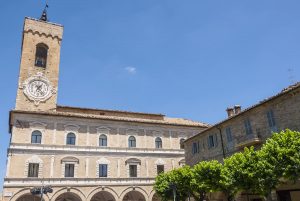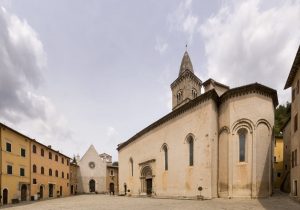
©Bigstock.com/Claudiogiovanni
The Adriatic coast to the east, the Apennines to the west and plenty of hilly countryside in between: Macerata is a very typical province for the Marche region, stretching across the entire width of the region, and could hardly be more diverse. Here you will find evidence of ancient civilisations – numerous Roman roads and settlements once ran through the entire province – and natural beauty. Hills rise right behind the coastal strip and lead you into an exciting region with the capital Macerata, rich in churches and theatres, as well as the magnificent harbour town of Civitanova Marche. The Italian private association “I borghi più belli d’Italia”, dedicated to the most beautiful places in Italy, found what it was looking for throughout these 2,773 km². Discover the nine most beautiful places in the Province of Macerata with us!
Cingoli
Our first stop is the so-called “balcony of the Marche region”. Cingoli (approx. 9,500 inhabitants) bears this name due to its elevated position on Monte Circe and features marvellous views. The area was inhabited by the Picentes as early as the 5th century BC and later developed into an important Roman settlement, traces of which you can see in the local archaeological museum. In the old town centre, on the other hand, you will be greeted by warm façades and magnificent Renaissance gates. The Concattedrale di Santa Maria Assunta on the main square was built in place of a small church to accommodate the influx of believers. Work on the paintings and frescoes continued into the 20th century.
Esanatoglia
According to legend, Esanatoglia (approx. 1,900 inhabitants) got its name from the river Esino, which in turn was named after the Celtic god of trade and war, Esus. Seven bell towers behind the town wall line the main street and lead you to the highlights of the still very medieval-looking town with the three front doors typical of the time. One of these bell towers is located next to the 12th century parish church of Santa Anatolia. According to historians, the Roman inscription on the tower is evidence of a Roman settlement from Augustinian times. San Martino, on the other hand, emanates Renaissance stylings and conceals a magnificent interior behind its rather plain façade. The fountain in front of the church, however, again dates back to the 12th century and once regulated the town’s water supply.
Montecassiano
A ring of walls and old buildings surrounds the centre of Montecassiano (approx. 7,000 inhabitants), idyllically situated on a small hill. Walking through these historically grown structures, you feel like you’ve been transported to a completely different time. Almost every street leads to the main square, which remains an important meeting place for the population today. Several palaces on and around the square combine a variety of architectural influences. An undisputed highlight, however, is the 13th century collegiate church of Santa Maria Assunta, extensively renovated and remodelled, from the terracotta façade to the altar, which also gleams with terracotta charm. In San Marco, you will not only find numerous 17th century paintings, but also a large archaeological collection with a Picentes focus.
Montecosaro
Montecosaro (approx. 6,800 inhabitants) is basically divided into two parts. In addition to the old town centre, you should definitely visit the newer district of Montecosaro Scalo, which was built around one of the most important sights in the entire region. The Basilica of Santa Maria a piè di Chienti probably has Romanesque roots and was eventually consecrated in 1125. Lombard in the nave and Burgundian in the apse, the church houses numerous statues and paintings of inestimable value. In addition, the vegetation around the basilica has recently been revitalised and adapted to the variety of trees of its foundation time. In the town centre, on the other hand, you will find numerous magnificent palaces and churches as well as the exciting Teatro della Loggia that was created in the 19th century from a medieval building and has now even been nominated as part of a World Heritage Site.

©Bigstock.com/Gianni62
Montelupone
Montelupone (approx. 3,400 inhabitants) has managed to retain its medieval charm to this day. The town is surrounded by large walls and four gates that used to be closed at sunset and reopened at sunrise. One of the older buildings is the small 14th century Palazzetto del Podestà that combines Lombard influences with more modern frescoes. Find the local art gallery as well as another museum of ancients arts and crafts in the Palazzo Comunale, built around 1800 in neoclassical style. You will pass countless residences of influential families on your way to the large churches. The baroque-style renovated church of San Francesco was once built by the Franciscans, although much of the furnishings have been relocated to museums or other churches, including the charming collegiate church.
San Ginesio
The variety of churches and monasteries in San Ginesio (approx. 3,400 inhabitants) is absolutely impressive. For example, there is the former Augustinian monastery, extensively extended and remodelled in the 17th century, with frescoes depicting the life of Saint Augustine. Lombard craftmanship, combined with Gothic and Romanesque styling, is made tangible in the collegiate church of Santa Maria Assunta, which you enter through an 11th century travertine portal, only to be wowed by similarly complex decor. San Francesco is also of Romanesque-Gothic origin while San Michele, dating from 996, is one of the oldest preserved churches in the province. And then there are the old sandstone town walls with four magnificent gates that, together with the medieval Rocca, once protected the town.
Sarnano
The ideal of a medieval castrum awaits you in Sarnano (approx. 3,000 inhabitants) with its elongated, elliptical structure, the still well-preserved walls, red tiled roofs and warm terracotta colours as well as the narrow, steep alleyways, all of which lead directly to Piazza Alta. All of the buildings on the main square were built at the end of the 13th century and round off the uniform appearance of the town. For example, the Palazzo del Popolo, which was converted into a theatre, has recently been extensively renovated in order to return to its origins. The church of Santa Maria Assunta is also fascinating due to its statues, panelled paintings and a magnificent wooden vexillum. Just outside Sarnano, the Benedictine abbey at the foot of Monte Sassotetto, which was later converted into a church and is home to numerous frescoes, and the hermitage of Soffiano, where a cave was built directly into the church, await you.
Treia
Treia (approx. 9,200 inhabitants) was called Montecchio until 1790 when Pope Pius VI gave it the name of the former ancient settlement and at the same time granted town rights. Here you can experience over 2,500 years of history in one place. According to research by the University of Ghent, countless Roman buildings are located beneath modern-day Treia. You can see some of the finds in the archaeological museum, and there is also another museum dedicated entirely to the history of the town. Lombard towers, 13th century city walls, and Renaissance and neoclassical buildings emphasise Treia’s eventful history. The Duomo, for example, was only built between 1782 and 1814, while the churches of San Filippo Neri and Santa Chiara are Baroque in style. The Palazzo Municipale town hall houses a collection of paintings with a Renaissance focus that can be viewed on request.

©Bigstock.com/mor65
Visso
Located directly on the Umbrian border in the mountains and in the Monti Sibillini National Park, Visso (approx. 1,200 inhabitants) is a beautiful, idyllic town with a surprising abundance of palaces. Many of them are summer residences that were built in the 15th and 16th centuries and attracted numerous aristocrats and wealthy families. This is also reflected in the variety of magnificent churches in the town, most notably the Romanesque-Gothic collegiate church of Santa Maria with frescoes from the Umbrian-Marche and Giotto-Rimini schools of painting. Behind the Gothic façade of the church of Sant’Agostino is the diocesan museum with valuable manuscripts by the poet Giacomo Leopardi. On the other hand, the full Renaissance splendour of the Marche region is brought to life in the Santuario di Macereto. Legend has it that donkeys transporting the statues of the Virgin Mary that is now housed in the sanctuary stopped at this very spot on 12 August 1359 and refused to go any further. The pilgrimage route is closely linked to the Basilica of the Holy House in Loreto.
Ranging from magical views to medieval originality, Renaissance and Baroque splendour and an intense exploration of Roman and Lombard history, the most beautiful places in the Province of Macerata certainly have something for everyone. You’ve certainly never experienced the Marche region like this before!